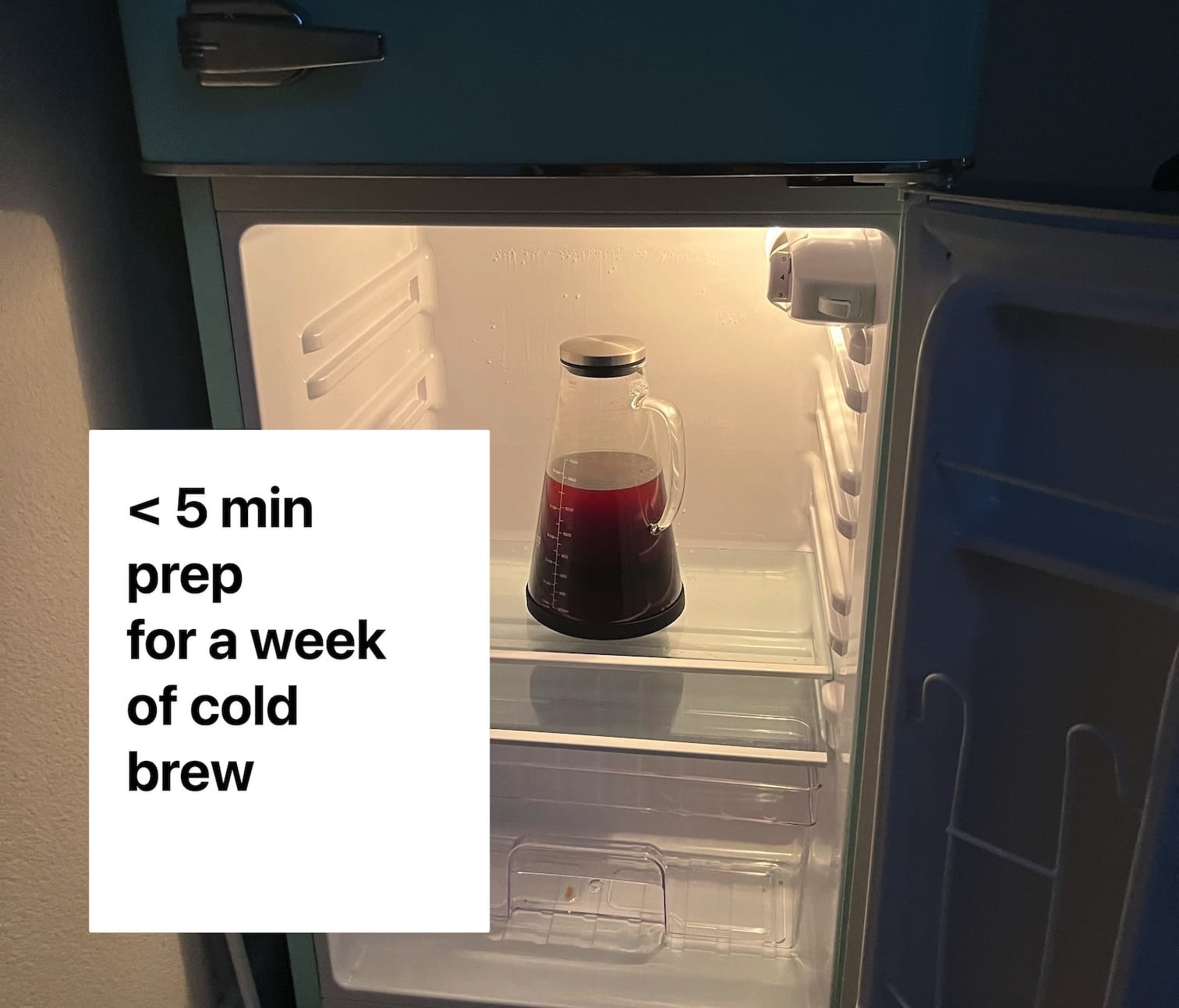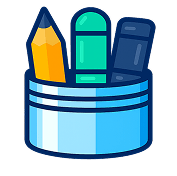New year, new coffee routine

This cold brew coffee making routine takes me less than 5 minutes and lasts me an entire week. Plus, you get my backstory on discovering I actually like coffee after many years as an avid tea drinker. Finally, I hope you take away what practical instructions like this have to do with technical writing evaluations and keeping the field inclusive to career switchers.
🤖🚫 This is human-authored content with a real human voice and no official style guide.
Backstory
Despite growing up in one of the coffee shop capitals of the world, I never acquired a taste for coffee. I confess I thought all coffee tasted like battery acid.
Then one mid-morning, I was strolling through a local farmer’s market when I noticed a table with sample cups extensively annotated with handwritten note cards. As I got closer, I realized it was a coffee tasting table. Intrigued by all the care (and words!), I tried a “low-acid” sample. Without anything added, it was astonishingly good. At last, I discovered I could like coffee.
With all the words I had collected from that samples table, I got really into researching and experimenting with coffee.
Still, it was never a part of a regular routine for me as an avid tea drinker. I didn’t want to commit to a long coffee-making routine every day and if I was honest, I also had another internal hurdle.
Am I a coffee nerd, a coffee snob, or both?
Those paper cards had introduced me to a whole lexicon of coffee tasting. Next thing I knew, I was into single-origin coffee and I was grinding small single cups with a hand cranked grinder for the “ritual” or fun of making it by hand in a coffee press.
I still couldn’t drink “regular” coffee from most places, though. I had to ask myself, “Does this make me a coffee snob?” As a longtime tea drinker, I enjoyed feeling distant from coffee snobbery, and yet here I was steeped in a privileged coffee culture with fancy gear and way more words about coffee than I needed. I had to ask myself: “Isn’t the definition of a coffee snob someone who refuses to drink any other coffee except their [insert elaborate description of their favorite coffee]?” By this definition, yes, I had become a coffee snob. 😬
But after some careful thought, I realize there’s more to being a coffee snob than strong preferences and big words.
(And yes, I’m aware I’ve redefined coffee snobbery in a convenient way to exclude myself from the definition—a classic move for uneasy consciences everywhere. I hope those closest to me though will help keep me honest.)
Here’s how I am thinking about it now:
| Coffee nerd 🤓 | Coffee snob 😒 |
|---|---|
| Enjoys expressing or feeling disgust and disdain over certain coffee preferences | |
| Enjoys feeling superior to others in relation to coffee preferences | |
| Can have highly selective coffee taste | Definitely has highly selective coffee taste |
| Enjoys expressing and/or collecting knowledge about coffee | Enjoys expressing and/or collecting knowledge about coffee |
| Knowledge enhances coffee experience | Knowledge enhances coffee experience |
It’s not so much about having strong preferences or even being disagreeable in how you express those preferences. For me, coffee snobbery is more about enjoying a feeling of superiority and experiencing disgust.
Certainly, there’s more to this, and you can technically be both, but I’d like to think I fit safely in the highly selective coffee nerd category. If I do verge on coffee snobbery, I at least want to be aware of it. To each their own brew. ☕
After this exploration, I was ready to build a coffee making routine that is optimized for my preferred taste and efficiency.
My favorite cold brew equipment & beans
There are lots of ways to make cold brew. You can even use just a jar with the right filter, but here’s the equipment I’ve gone with and why.
Grinder
I got into hand crank grinders at first but once efficiency took over, I settled for a simple electric grinder you can find at most in-person stores.
Pitcher
For my cold brew coffee pitcher, I looked for one made of glass or stainless steel.
I’ve been pleased with the RJ3 Ovalware Cold Brew Maker, although its shape can be awkward in your fridge, it’s well-made and straightforward to use.
My favorite coffee beans
For my coffee beans, I’ve been a happy subscriber of Purity Coffee (no, they’re not sponsoring this post!).
First, their coffee tastes amazing. I go for their Ease blend, which is particularly good for cold brew and low on acidity. 😊
Second, they’re a company I respect and appreciate for their commitment to transparency and their care for the craft of coffee making. They show care for the people who grow, harvest, and process the coffee beans they sell.
Third, they make the science of coffee accessible and clear while committing to communicating nuance.
You can check out their offerings at Purity Coffee or check out their care for nuance in their approach statement. I wouldn’t be surprised if they have science writers on their team.
My weekly cold brew batch
Here’s my go-to cold brew coffee making routine, which takes me less than 5 minutes of prep before it brews overnight.
What you need
- Water
- Coffee bean grinder
- Cold brew pitcher with a filter or a large jar with a filter
- Coffee beans (To enhance the flavor of your coffee, I recommend buying coffee beans and grinding them yourself.)
To learn about my favorite coffee beans, cold brew pitcher, and more, check out my cold brew equipment.
Create an overnight cold brew batch
Follow these steps the night before you want to have your cold brew coffee ready to drink:
Grind coffee beans to a medium grind until you have about 85g/110g or 1 cup of coffee grounds. This recommended amount is based on my preferred cold brew pitcher and its filter, which you can learn more about in my cold brew equipment recap.
Scoop the coffee grounds into your cold brew pitcher’s brewing filter until it is 2/3 full.
With the brewing filter in place, fill up your cold brew pitcher with cold water, ideally filtered water if possible.
Seal the cold brew pitcher with the lid and set it in a fridge for 10-16 hours.
After 10-16 hours, remove the filter.
Now your cold brew coffee is ready to drink!
You can pour yourself a cup and add more water (Americano style) or milk to your liking. Also, you can make your coffee more concentrated by brewing it for a longer time or adding more coffee grounds. I like to make it more concentrated so that it can last me an entire work week. Making coffee concentrate is also where low-acidity coffee shines, since it’s harder to overbrew.
What does this have to do with technical writing?
Why am I writing about coffee if this is a work-themed blog? Once, I was on a tech writing team that evaluated candidates based on the instructions they gave for making a meal. (There were other parts to this evaluation as well but this was one of my favorite parts!)
This evaluation approach was ideal in so many ways. It helped people without explicit tech writing careers shine without big portfolios, wasn’t a huge time demand, and didn’t count as free work.
Some of the best technical writers I’ve ever worked with have worked in the following roles first:
- Car seat installation instructor
- Mechanical engineer
- IT System Administrator
- ESL/EFL instructor
- English teacher
- School teacher
- Translator
- Various roles at a public library
- Medical researcher
- Physics professor
- Technical support
- And many more other roles!
Often, people drawn to technical writing as a craft find opportunities for technical translation in almost any role they take on because they see the need and they have the care for it.
I’d like to see more hiring folks use this kind of evaluation approach. This approach does require someone hiring to have a deep understanding of the craft and may require more time.
A few years into my transition into technical writing, someone with much more experience than me asked me directly “How could you be doing this work with so few years of experience?” I remember feeling shocked but also grateful this person had verbalized something I felt like I had encountered from others but a lot less explicitly.
I realized the privilege I’ve had to join a team that valued career switchers and was confident enough in its craft to hire people who could learn and grow into the role. (Noting this is pretty common in tech writing as most people don’t even know what a technical writer is.)
Of course, there are probably additional concerns today that people could just use AI tools for take-home assessments. Still, I’ve heard of creative workarounds for that, such as live pairing sessions and requiring candidates to sign statements that they’re not using AI assistance in writing evaluations, which can at least test their gall and thinking under pressure.
Why more tech writers & documentarians should document real-life
Documenting real life can showcase fundamental technical writing skills! If you have a work blog, consider documenting something that you care about.
Also, there’s a lot you can glean about a person by the way they write when they care about something. Writing about what you care about, whether it’s your favorite seasonal drink or your take on a business strategy, is a way to understand someone’s humanness, which we could use more of these days.
And you?
If you have a favorite recipe or drink to share, I’d love to hear about it!
Till next time. ✌🏽
More to check out
Loading comments...

Comments
Join the conversation on Bluesky